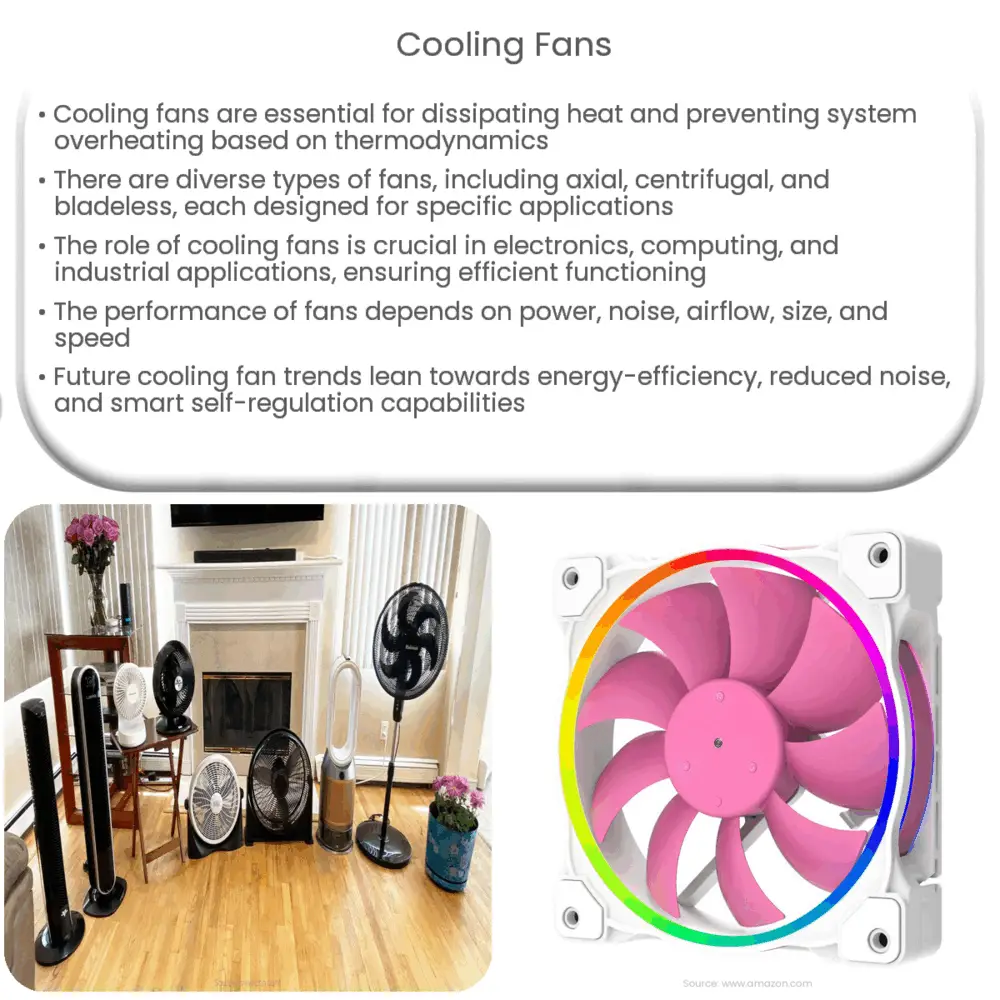Explore the essential role of cooling fans in electronics and industrial machinery, their types, performance factors, selection process, and future trends.

Understanding Cooling Fans
The science of cooling fans revolves around the basic principle of thermodynamics – heat transfer. Cooling fans are devices designed to move air or other gases, aiding in heat dissipation and thereby preventing overheating of various systems.
Types of Cooling Fans
There are several types of cooling fans, each designed for specific applications. This range of diversity allows for a tailored solution for unique requirements, ensuring optimal performance and longevity.
- Axial Fans: As the most common type of cooling fan, axial fans are used in a variety of applications, including personal computers, air conditioning units, and many more. The blades in axial fans are designed to draw air along the axis of the fan, hence the name.
- Centrifugal Fans: Centrifugal fans, also known as blower fans, use rotating impellers to increase the pressure of the air stream, which is then moved sideways. These are commonly used in HVAC systems, industrial processes, and automotive cooling.
- Bladeless Fans: These innovative fans, popularized by Dyson, use aerodynamics to draw in air and expel it with increased velocity. They are safer and quieter than traditional fans.
The Role of Cooling Fans in Technology
With the rapid advancement in technology, the role of cooling fans has become paramount, especially in the fields of electronics and computing.
- Computer Cooling: Overheating is a serious threat to the efficient functioning and lifespan of computer systems. Here, cooling fans maintain an optimal temperature, helping components like CPUs and GPUs function efficiently.
- Industrial Applications: In industrial settings, cooling fans are essential for maintaining the temperature of machinery and preventing breakdowns, thereby promoting operational efficiency and safety.
Cooling Fan Performance Factors
The performance of a cooling fan is determined by various factors such as power, noise levels, airflow, fan size, and speed. The fan’s power determines the rate at which it can move air. Noise level, often measured in decibels (dB), is another important factor, especially for applications where silent operation is a priority. Airflow is measured in cubic feet per minute (CFM), and it indicates the volume of air that a fan can move in a minute.
How Cooling Fans Work
The fundamental operation of a cooling fan can be summed up in three steps:
- The electric motor in the fan spins the fan blades.
- This spinning generates an airflow by displacing air from the area behind the fan to the area in front of it.
- The airflow then aids in transferring heat away from the system, causing a cooling effect.
Factors to Consider When Choosing a Cooling Fan
With a wide variety of cooling fans available in the market, selecting the right one can seem daunting. However, keeping a few key factors in mind can simplify this process:
- Application: The intended use of the cooling fan plays a significant role in selection. For instance, an axial fan would be more suitable for a personal computer, while a centrifugal fan would better serve an HVAC system.
- Size and Power: The size and power of the fan directly impact its ability to dissipate heat. More powerful fans can move air at a faster rate, resulting in better cooling. However, a larger, more powerful fan may also generate more noise.
- Noise Levels: Depending on where the fan will be used, noise may or may not be a concern. In a server room, for example, noise levels are less critical, but in a living room, a quieter fan would be more desirable.
- Energy Efficiency: As with any electric device, energy efficiency is a crucial consideration. High-efficiency fans consume less power, leading to savings on electricity bills.
Evolution and Future Trends
The evolution of cooling fans has been parallel with advancements in technology. As devices continue to shrink and their power density increases, the need for efficient cooling solutions escalates. Future trends indicate a shift towards more energy-efficient, quieter, and smarter cooling fans. The integration of sensors and advanced control systems will likely allow cooling fans to self-regulate, adjusting their speed based on the system’s temperature.
Maintenance of Cooling Fans
To ensure longevity and optimal performance, regular maintenance of cooling fans is essential. This process usually involves cleaning to remove dust and other debris that could obstruct airflow and checking the fan’s bearings and motor for signs of wear or failure.
Conclusion
In conclusion, cooling fans play an integral role in a variety of applications, ranging from personal electronics to industrial machinery. Their primary function is to maintain the optimal temperature of systems, preventing overheating and promoting efficient functioning. While there are several types of cooling fans, each with their unique advantages, the selection often boils down to the specific requirements of the application. As technology continues to evolve, we can expect to see smarter, more efficient, and quieter cooling fans in the future. Regardless of these advancements, the fundamental principle of these devices remains the same – facilitating heat transfer through airflow, keeping our machines cool, and our world running smoothly.



